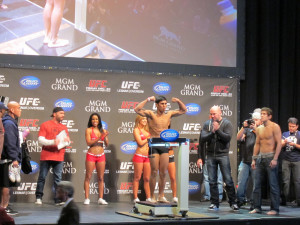 Sauna suits while running on the treadmill, hours of sitting in the sauna wearing sweat suits, Epsom salt baths with menthol, the inability to drink water or eat for 24 hours, all while continuing fight preparation. This is the reality for most fighters the day before the weigh-ins with at least another 15 pounds to shed, often known as “drying out.” It would seem some fighters are nearly dead when they stand before thousands to weigh into their respected weight class. For these athletes, cutting massive amounts of weight the day before allows them to fight heavier than if they properly cut weight throughout their training camp. After weighing in, the fighters are rushed to their hotel room with one thing on their mind—rehydrating. However, due to the deprivation of food and liquid for at least 24 hours, their bodies cannot take in enough liquids orally to rehydrate without the side effect of increased dehydration. The use of IV’s has become the norm for the fighters. It allows them to hydrate properly and replace the vitamins that were depleted from their systems.
Sauna suits while running on the treadmill, hours of sitting in the sauna wearing sweat suits, Epsom salt baths with menthol, the inability to drink water or eat for 24 hours, all while continuing fight preparation. This is the reality for most fighters the day before the weigh-ins with at least another 15 pounds to shed, often known as “drying out.” It would seem some fighters are nearly dead when they stand before thousands to weigh into their respected weight class. For these athletes, cutting massive amounts of weight the day before allows them to fight heavier than if they properly cut weight throughout their training camp. After weighing in, the fighters are rushed to their hotel room with one thing on their mind—rehydrating. However, due to the deprivation of food and liquid for at least 24 hours, their bodies cannot take in enough liquids orally to rehydrate without the side effect of increased dehydration. The use of IV’s has become the norm for the fighters. It allows them to hydrate properly and replace the vitamins that were depleted from their systems.
Earlier this year, the UFC teamed up with the U.S. Anti-Doping Agency (“USADA”) as an independent governing body to regulate drug testing. The fighters, who are subject to standards without say because they are independent contractors and do not have a union, thought this was necessary to protect themselves. Fighters have always been subjected to post-fight drug testing, which many times revealed performance enhancing drugs and other banned substances, all at the UFC’s discretion. Now, with the USADA, the athletes thought it would be in their favor because substance regulation would remain objective.
Unfortunately, this also created a more stringent drug testing policy where the fighters can only hydrate using IV’s if they need hospitalization. Under the USADA, all IV infusions and/or injections of more than 50mL per 6-hour period are prohibited unless received legitimately in the course of hospital admissions. Any infractions to this new USADA regulation, the athlete will receive a two-year suspension from the sport. The original date of implementation was to begin on July 1, 2015. When the USADA realized how many fighters would be affected and the high risk of dehydration, athletes were given an additional three months to adjust their training camps to remain in compliance with the new regulation.
One of mixed martial arts top nutritionists stated that about 99% of fighters are currently using IV’s to rehydrate after weigh-ins. If the fighters are not able to properly hydrate, not only are their reflexes dulled, but remaining dehydrated may also have debilitating effects on brain injury. The brain is protected by Cerebrospinal fluid, a liquid cushion that is mostly made up of water. Studies show that 3 kilograms of sweat loss is associated with a reduction of 30% of that liquid. When a knockout occurs, the brain hits the skull. If the fighter remains dehydrated, the chances of experiencing a knockout are more likely because the cushion around the brain is thinner. The UFC is exposing their athletes to increased risks of a knockout by prohibiting IV hydration. The rate of traumatic brain injury exposure for an MMA fighter is already at 15.9% where the NFL is 8.08% and the NHL is about 2.2%. This number is likely to increase if the athletes do not find ways to remain hydrated after weight cutting.
After weigh-ins of the first UFC fight card where the IV ban was implemented, one fighter was rushed to the emergency room suffering kidney stones and intestinal blockage—both complications of dehydration. Although it appears that the UFC is trying to increase the longevity of their athletes, the results may be worse before they get better. Athletes have their routines that are often difficult to break. Those from the era of “drying out” may find it difficult to change now, and this new rule may have detrimental effects leading to permanent brain injuries.
